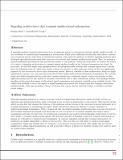Signaling architectures that transmit unidirectional information
Author(s)
Shah, Rushina; Del Vecchio, Domitilla
Downloaddspace_submission.pdf (1.214Mb)
Metadata
Show full item recordAbstract
A signaling pathway transmits information from an upstream system to downstream systems, ideally unidirectionally. A key bottleneck to unidirectional transmission is retroactivity, which is the additional reaction flux that affects a system once its species interact with those of downstream systems. This raises the question of whether signaling pathways have developed specialized architectures that overcome retroactivity and transmit unidirectional signals. Here, we propose a general mathematical framework that provides an answer to this question. Using this framework, we analyze the ability of a variety of signaling architectures to transmit signals unidirectionally as key biological parameters are tuned. In particular, we find that single stage phosphorylation and phosphotransfer systems that transmit signals from a kinase show the following trade-off: either they impart a large retroactivity to their upstream system or they are significantly impacted by the retroactivity due to their downstream system. However, cascades of these architectures, which are highly represented in nature, can overcome this trade-off and thus enable unidirectional information transmission. By contrast, single and double phosphorylation cycles that transmit signals from a substrate impart a large retroactivity to their upstream system and are also unable to attenuate retroactivity due to their downstream system. Our findings identify signaling architectures that ensure unidirectional signal transmission and minimize crosstalk among multiple targets. Our results thus establish a way to decompose a signal transduction network into architectures that transmit information unidirectionally, while also providing a library of devices that can be used in synthetic biology to facilitate modular circuit design.
Description
Submitted for review.
Date issued
2016-12-24Keywords
signal transmission; cellular signaling; retroactivity; unidirectional signal transmission; phosphorylation; phosphotransfer; reaction-rate equations; mathematical models